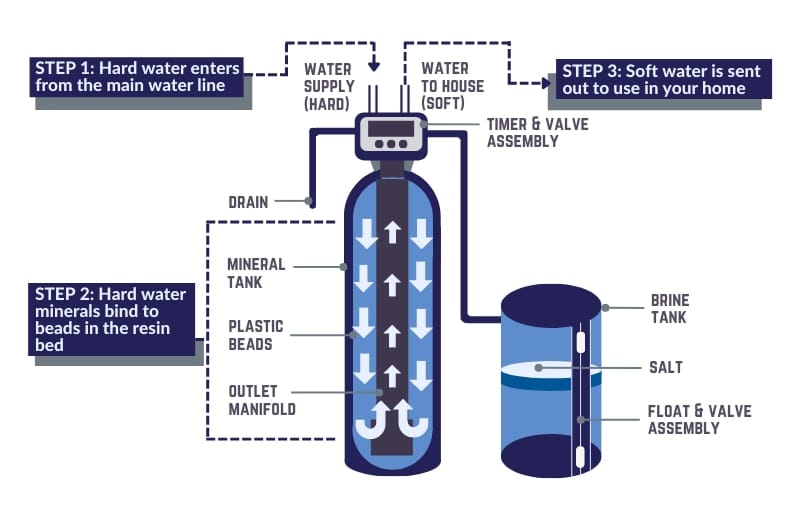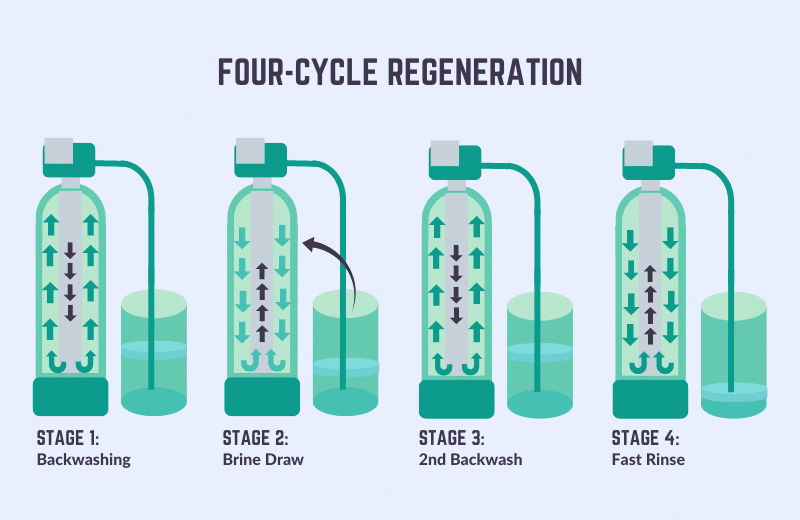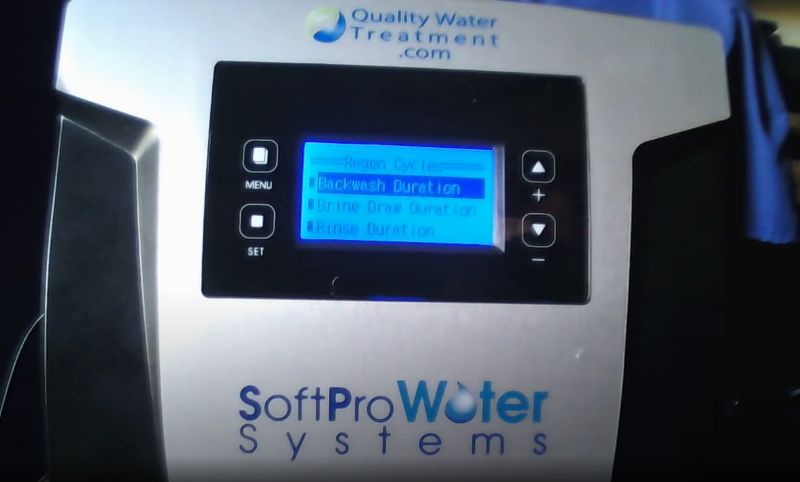One of the key performance features of a traditional salt-based water softener is the regeneration cycle. The softening process would be cut short very quickly in a water softener that didn’t regenerate.
In this guide, we’ve answered the question, “what is water softener regeneration?”, and shared everything you need to know about how a regeneration cycle works.
📌 Key Takeaways:
- Water softener regen (regeneration) is when a water softener sends water through the resin bed to remove hardness minerals and replenish sodium ions.
- The regeneration process works by drawing a brine solution from the brine tank and flushing it through the resin, sending the trapped minerals down the drain.
- There are five steps involved when a water softener regenerates: brine tank fill, backwash, resin brine draw, brine rinse, and fast rinse.
Table of Contents
🔀 What Is Water Softener Regeneration?
Water softener regeneration is when a water softener flushes hardness minerals out of the resin tank, replenishing a softening material called resin with sodium ions. This allows the system to continue to effectively soften water.
Hard water is softened in a salt-based water softener in a process called ion exchange. The magnesium and calcium hard minerals are exchanged with sodium ions, which are pre-loaded in the softener’s resin bed.
This process can only remain effective if the water softener periodically cleanses the resin bed to flush out the minerals when it becomes saturated.
🔎 How Does Water Softener Regeneration Work?
The water softener regeneration process works by removing the trapped hardness minerals in the resin bed.
To understand how regeneration works, let’s quickly recap how the water softening process works.
In a salt-based softener:
- Hard water flows through the resin (or mineral) tank, where the hard minerals are attracted to a charged resin.
- The minerals stick to the resin beads, and equal amounts of sodium are released from the resin to balance water’s charge.
- The now soft water flows out of the softener tank and through your plumbing.

This process happens constantly whenever you open a faucet or switch on a water-using appliance.
The resin bed can only hold so much sodium. Eventually, so much water will flow through the resin that it becomes depleted of sodium and saturated with hardness ions.
When this happens, the resin can no longer soften water because there’s no sodium left. This is when a softener should regenerate.
The system will send brine (salty water) through the resin to flush away the hardness ions. The brine water comes from the salt tank, or brine tank, which is pre-loaded with salt.
👨🔧 It’s your responsibility to keep the tank topped up with salt pellets or crystals so that regeneration can take place effectively at any time.
The size, design, and efficiency of the water softener determine exactly how long regeneration takes and how much water is used in the process.
What Happens To Your Water During Softener Regeneration Cycle?
During regeneration, you won’t have access to softened water. The softening unit will be otherwise engaged while the resin bed is being flushed, so you’ll have to restrict your household water usage for before or after the regen cycle.
Since most water softeners regenerate at around 2am-3am, you probably won’t need to use water at this time anyway.
Related: Can you use water while your water softener is regenerating?
If you do desperately need water, though, you won’t be cut off entirely. Your whole house water supply will simply bypass the water softener, so you’ll have access to normal hard water, rather than softened water flowing through the softener unit.
Once regen is complete, your water supply will automatically bypass back through the softener, and you’ll have soft water again.
📌 The exception is if you have a dual tank or twin tank softener. Twin tank water softeners have two resin tanks, so when one tank is being flushed, the other tank is still being used for ion exchange. That means you always have access to soft water.
📊 Stages Of Water Softener Regeneration
There are five stages involved when a water softener regenerates:
- Brine tank fill – Water flows into the brine tank, filling to just below the salt level.
- Backwash – The resin beads are flushed in a backwashing process, removing the minerals.
- Resin tank brine draw – Brine is drawn from the brine tank and reverse ion exchange takes place.
- Brine rinse – The brine valve closes and the resin is rinsed again. Lingering brine is washed down the drain.
- Fast rinse – A final fast rinse cycle occurs in the resin, which causes the resin beads to become compacted and ready for the softening process once more.
You can check out our guide on these water softener regeneration steps for a more thorough explanation of the step-by-step process.

🤔 Why Is Water Softener Regeneration Needed?
Regeneration in a water softener is needed to reload the resin beads with salt.
Without salt, the ion exchange process couldn’t take place. There would be nothing to exchange with the calcium and magnesium ions to balance water’s charge, so water couldn’t be softened.
All operating water softeners eventually run out of salt in the resin bed. The purpose of the regeneration process is to send more salt into the resin tank from the brine tank. If regeneration didn’t take place, the water softener would become useless within a matter of days.
📖 How To You Know When A Water Softener Is Regenerating
So, now you know the science of what softener regeneration is and how it works.
But how do you know when a water softener is regenerating?
As we mentioned, most water softeners regenerate in the early hours of the morning, so unless you wake up at the right moment, you probably won’t even know when the regeneration process takes place.
If you happen to be awake while your water softener is regenerating, you’ll hear whirring, mechanical sounds and rushing water, which is the sound of the brine solution flowing through the resin tank.
💡 You can also check your water softener valve (found on top of the resin tank). During a water softener regeneration cycle, the digital screen on the control valve will usually say “REGEN”.
The final test is to pour a glass of water. If you don’t think it looks or tastes like softened water, you’re probably drinking hard water that has been diverted around the water softener system during regeneration.

❔ What is Water Softener Regeneration (“Regen”)? FAQ
How long does water softener regeneration take?
Water softeners take about 2 hours to regenerate from start to finish. The exact time depends on factors including the unit size, the softener’s salt and brine capacity, and the design of the unit.
How often does a water softener regenerate?
Water softeners regenerate every 1-2 weeks on average. Your hard water level and your water usage affect the frequency of regeneration, as well as the system size and model.
How do I change my water softener’s regeneration settings?
You can change the time and frequency of regeneration on your water softener’s control valve. You can also program a regeneration cycle manually if you think there’s a problem with your unit’s regeneration schedule.
What’s the difference between demand initiated and time initiated regeneration?
Demand regeneration is triggered once a specific amount of water flows through the softener. It saves both salt and water compared to time initiated water regeneration, which is triggered once a specific amount of time has passed. Most of the best modern water softening systems nowadays use demand initiated regen.
How much water is used when a water softener recharges?
Between 30 and 65 gallons of water are used on average when a water softening system regenerates.

